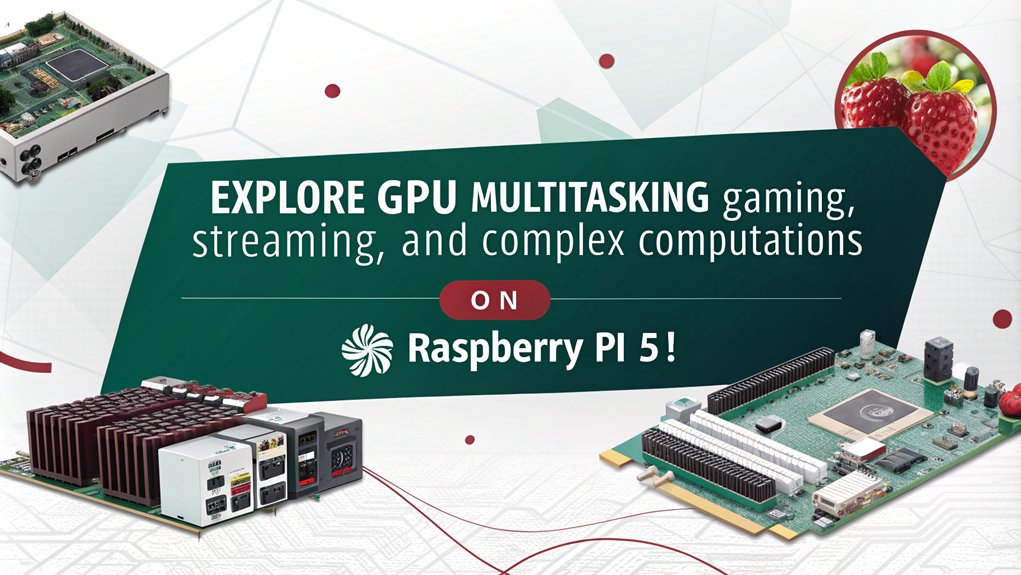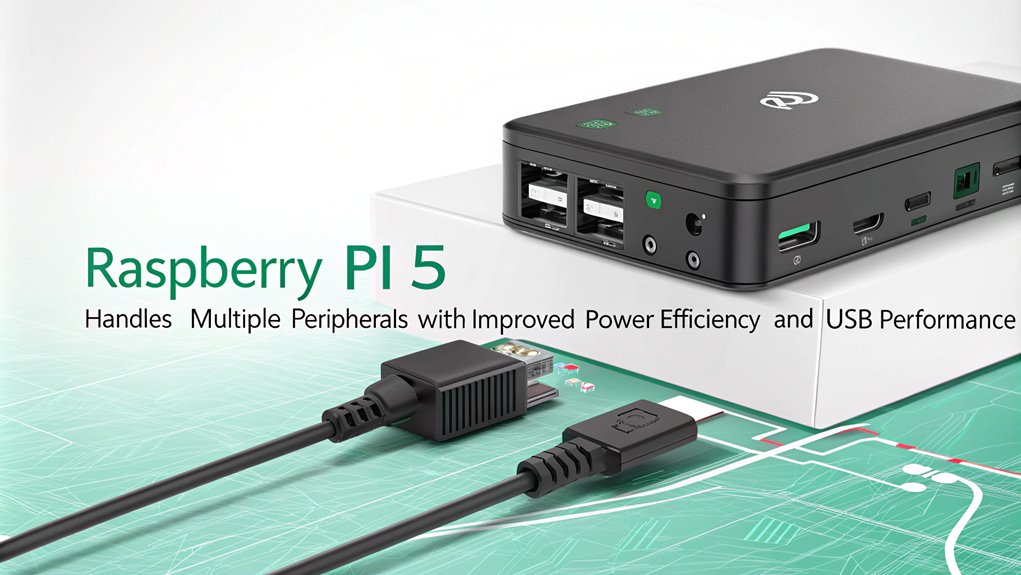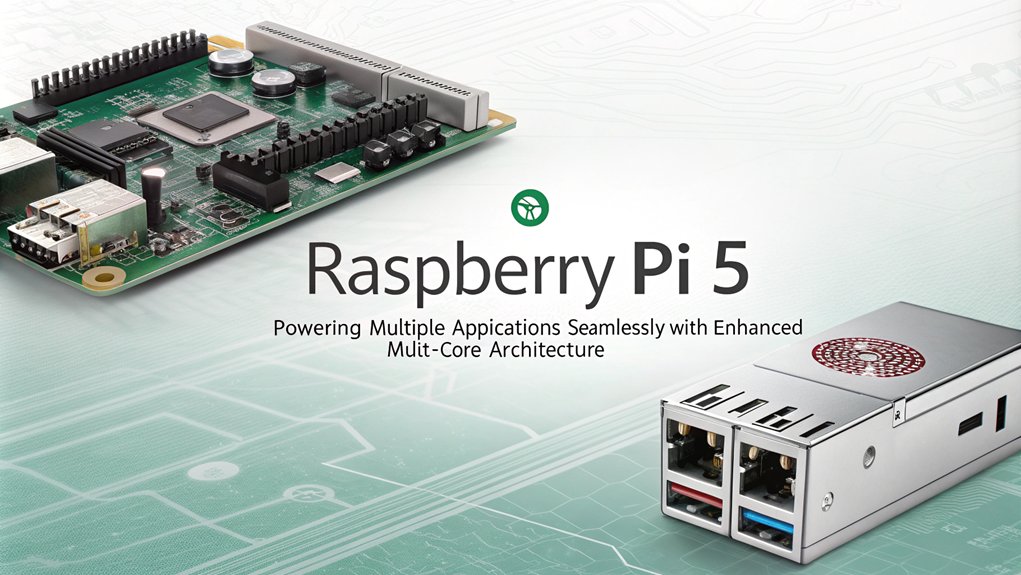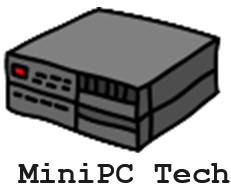The Raspberry Pi 5 multitasking capabilities are impressive, thanks to its quad-core ARM Cortex-A76 CPU running at 2.4 GHz. With up to 8GB of RAM, you can efficiently manage multiple demanding applications simultaneously. It excels in AI-driven tasks, content creation, and multimedia processing, seamlessly handling 4K video playback and editing. The dual Gigabit Ethernet and WiFi 6 provide fast and reliable connectivity for online tasks. Plus, its advanced GPU enhances graphics performance, making it perfect for various projects. Stick around, and you’ll discover even more about how this versatile device can enhance your projects.
Key Takeaways
- The Raspberry Pi 5’s quad-core ARM Cortex-A76 architecture offers up to 3x better performance for multitasking compared to previous models.
- With up to 8GB of RAM, it efficiently handles multiple concurrent applications and complex tasks.
- Dual Gigabit Ethernet and WiFi 6 support enhance internet connectivity, allowing for simultaneous data-intensive operations.
- The powerful Broadcom VideoCore VII GPU manages demanding graphics and 4K video playback, ideal for multimedia editing and processing tasks.
- Community-driven improvements ensure ongoing software optimization, enhancing multitasking capabilities for a variety of applications.
Raspberry Pi 5 Multitasking Capabilities Due to Enhanced CPU Performance
The Raspberry Pi 5 brings a remarkable leap in enhanced CPU performance, making it a powerful option for multitasking. With its quad-core ARM Cortex-A76 architecture clocked at 2.4 GHz per core, you’ll notice significant speed improvements compared to the Raspberry Pi 4.
In fact, CPU benchmarks indicate the Pi 5 achieves scores up to three times better for single and multi-core workloads, and over four times faster on CPU-specific tasks. This means you’ll experience seamless multitasking, even with resource-intensive applications. Furthermore, despite the higher power consumption from its increased performance, effective cooling solutions can help maintain optimal operation during demanding tasks. Additionally, its total RAM capacity of 7572.4 MB further enhances the multitasking experience by allowing more applications to run concurrently without slowdown.
The enhanced performance also benefits from community-driven improvements, which ensure continuous evolution and optimization of the operating system and software running on the Raspberry Pi 5. However, it’s crucial to keep heat management in mind. The increased performance generates more heat, so for intensive tasks, an additional cooling solution is recommended to maintain peak functioning.
While the 16nm manufacturing process isn’t as efficient as newer technologies, you can still enjoy powerful performance. The performance governor settings allow you to adjust power consumption for lighter tasks, but be prepared for higher usage during demanding operations.
Ultimately, the Raspberry Pi 5’s enhanced CPU performance empowers innovative projects like AI-driven applications, real-time data processing, and anything that requires robust multitasking capabilities. You’ll be impressed by what this compact powerhouse can accomplish
Upgraded Networking and Connectivity

With its enhanced CPU performance, the Raspberry Pi 5 sets the stage for impressive multitasking capabilities, but that’s not all it offers. Upgraded networking and connectivity features elevate your projects with greater versatility and reliability. The inclusion of dual Gigabit Ethernet ports not only allows for fast data exchange but also guarantees network redundancy, giving you a stable connection for networking-intensive applications. Moreover, this upgraded processor facilitates significant boost in data processing speed, enabling seamless performance even when running multiple resource-heavy applications simultaneously. Additionally, while it can function as a Wi-Fi access point, its performance may not match dedicated routers, making it best for small spaces.
Whether you’re setting up a robust home network or developing innovative IoT projects, the Raspberry Pi 5’s capabilities in wireless stability are remarkable. By integrating WiFi 6 and Bluetooth 5.2, you can expect faster and more reliable wireless connections. The device’s support for up to 8GB RAM also enhances its ability to handle complex tasks efficiently. This energy efficiency aligns well with sustainability goals, reducing the overall carbon footprint of your projects.
Here’s a quick overview of the connectivity upgrades:
| Feature | Benefits |
|---|---|
| Dual Gigabit Ethernet | Enhanced network throughput and reliability |
| WiFi 6 | Faster speeds and improved wireless stability |
| USB 4.0 | Supports higher bandwidth peripherals |
These advancements guarantee that the Raspberry Pi 5 can handle demanding multitasking scenarios with ease, making it an excellent choice for cutting-edge projects that require desktop-class performance. Embrace the future with improved networking capabilities.
Advanced GPU Capabilities

Raspberry Pi 5 showcases remarkable advanced GPU capabilities that greatly enhance graphics performance and multitasking efficiency. At its core, the Broadcom VideoCore VII GPU pushes the boundaries of what’s possible, upgrading from the previous generation’s VideoCore VI. With support for OpenGL ES 3.1 and Vulkan 1.2, you can expect smoother graphics rendering and improved visuals across applications. Additionally, the fantastic performance provided by external GPUs allows for even more demanding tasks, further elevating its capabilities.
Testing confirms the Raspberry Pi 5 handles 4K@60 effortlessly, featuring dual 4Kp60 display output over HDMI. Its built-in 4Kp60 HEVC decoder elevates video playback, making it ideal for multimedia projects or gaming. You can seamlessly play games like Portal and Minecraft, even if some compromises are necessary at lower speeds. With the 2.4GHz quad-core CPU and 2–3× CPU performance increase over Raspberry Pi 4, multitasking is further enhanced, ensuring smoother operation across multiple applications.
Driver support is robust, with the open-source V3D driver stack integrated into Raspberry Pi OS updates, and ongoing enhancements promise even better performance in upcoming releases. Whether you’re developing graphics-rich applications or multitasking with ease, the Raspberry Pi 5’s advanced GPU capabilities guarantee you won’t be left wanting. With its ability to support external GPUs over PCIe, the possibilities for high-performance graphics are expansive.
Improved Power Supply and USB

Significant improvements in power supply and USB capabilities set the Raspberry Pi 5 apart from its predecessors. The Pi 5 requires a robust 5V/5A USB Type-C power supply, providing 27W for peak performance beyond low power mode. Its power management is enhanced by the DA9091 chip, which guarantees better power delivery and accommodates additional power demands, making it essential for high-performance applications. You’ll notice a substantial upgrade in USB performance, with the introduction of USB 3.0 ports that operate at 5Gbps. This advancement means you get higher throughput without shared bandwidth, allowing multiple devices to connect efficiently. Furthermore, improved power delivery enables you to power devices like portable storage and optical drives seamlessly. With M.2 NVMe SSD support, the Raspberry Pi 5 can further elevate data transfer rates, benefiting multitasking capabilities in demanding projects. However, the increased power consumption necessitates better cooling solutions, such as passive heat sinks or active cooling fans, to manage thermal output effectively. While the Pi 5 can work with older 5V/3A power supplies, peak function is best achieved with the new power requirements. Overall, the Raspberry Pi 5 elevates multitasking capabilities through refined power management and enhanced USB performance, assuring you’re equipped for demanding projects. The support for USB 3.0 ports significantly enhances data transfer speeds and overall multitasking efficiency.
Superior Multi-Core Functionality

The enhancements in power supply and USB capabilities lay a solid foundation for the superior multi-core functionality of the Raspberry Pi 5. Utilizing a quad-core ARM Cortex-A76 processor clocked at 2.4GHz, the Raspberry Pi 5 greatly improves performance across both single and multi-threaded applications. This architecture not only boosts your computing power but also enhances multitasking efficiency, enabling smoother operation even when running demanding programs. Efficient core allocation typically requires no manual intervention, allowing developers to focus on optimizing their applications rather than managing resource distribution.
When you engage with performance benchmarks, the Raspberry Pi 5 achieves impressive scores: multi-core scores of 1604±22 in Geekbench 6 reflect a notable step up from its predecessor. Sysbench results show a 1.49x increase in multi-threaded performance, while Stress-ng tests indicate an impressive 1.78x enhancement. This is further supported by the fact that Raspberry Pi 5 has shown a performance increase of ×2.2 over Raspberry Pi 4 in multi-core performance, highlighting its capabilities. Additionally, this performance boost makes it an excellent tool for STEM education, enhancing student engagement in various subjects.
The improved performance also allows for better handling of resource-intensive tasks such as video editing with tools like OpenShot, which can now manage lower resolutions more efficiently.
This makes the Raspberry Pi 5 an outstanding choice for applications that rely on heavy parallel processing, such as AI projects, web browsers, and multimedia processing. However, to fully harness this multi-core prowess, consider cooling solutions to combat potential heat generation.
Frequently Asked Questions
Can Raspberry Pi 5 Run Multiple Virtual Machines Simultaneously?
Yes, you can run multiple virtual machines simultaneously on Raspberry Pi 5. Its impressive virtual machine performance, combined with efficient system resource allocation, allows you to manage various tasks smoothly and effectively. Enjoy enhanced multitasking!
What Operating Systems Are Compatible With Raspberry Pi 5 for Multitasking?
For multitasking on your Raspberry Pi 5, you can use Raspberry Pi OS, particularly the 64-bit version, or Ubuntu Server. Both offer excellent support for running multiple applications simultaneously, maximizing your device’s performance.
How Does Raspberry Pi 5 Compare to Other Mini PCS for Multitasking?
When you compare the Raspberry Pi to mini PCs, you’ll notice mini PC benchmarks often outperform in multitasking. Raspberry Pi comparisons highlight its efficiency for simple tasks but may struggle with high-demand applications needing more power and RAM.
Can Raspberry Pi 5 Perform Heavy Gaming While Multitasking?
Yes, you can enjoy improved gaming performance on the Raspberry Pi 5 while benefiting from its multitasking efficiency. Its powerful CPU and expanded RAM allow seamless gameplay alongside other demanding applications without lag or slowdown.
What Cooling Solutions Are Recommended for Raspberry Pi 5 Under Heavy Loads?
Think of your Raspberry Pi 5 as a race car; without proper cooling, it overheats. For heavy loads, consider active cooling solutions like fans or advanced water setups, alongside passive cooling options like heatsinks to maintain performance.
Conclusion
To sum up, the Raspberry Pi 5’s superior specs shine when it comes to multitasking. Its enhanced CPU performance, upgraded networking, advanced GPU capabilities, and robust power supply work harmoniously to handle heavy workloads. Whether you’re building a brilliant home automation system or experimenting with exciting projects, this powerhouse proves it can manage multitasking magnificently. Immerse yourself in the world of possibilities, and let the Raspberry Pi 5 elevate your electronic endeavors with excellence!

I am a retired software engineer with experience in a multitude of areas including managing AWS and VMWare development environments. I bought a relative a mini-PC a year ago and have become passionate about the technology and its potential to change how we deploy software.

